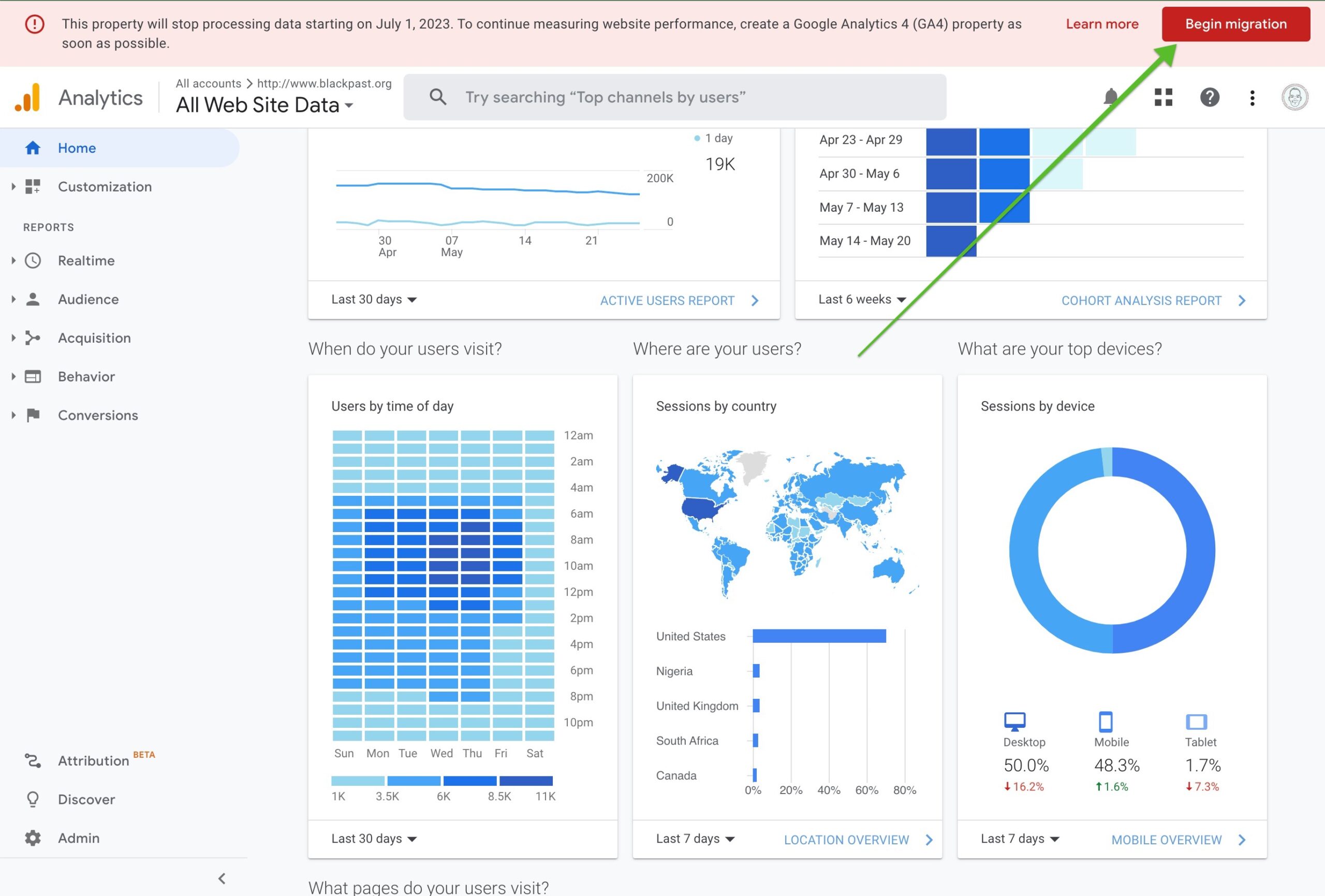Google Analytics 4 (GA4) is a powerful tool to help you understand how visitors use your website, so if you’re currently running Google’s Universal Analytics, you should switch to GA4 as soon as possible.
Intro
For years Google’s Universal Analytics (UA) was the best, or at least the most widely used, way to analyze your website traffic and your visitors’ behavior. It was so widely adopted because it was simple, powerful, and easy to pick up. The learning curve was low, and users quickly came to understand and enjoy how it works.
 In terms of inspection, UA was equivalent to a simple jeweler’s loupe. A jeweler’s loupe is tremendously useful. It’s that little magnifying device they use to look at gemstones to get an idea of how they rate. Many jewelers carry it around in their pocket so they can use it at a moment’s notice.
In terms of inspection, UA was equivalent to a simple jeweler’s loupe. A jeweler’s loupe is tremendously useful. It’s that little magnifying device they use to look at gemstones to get an idea of how they rate. Many jewelers carry it around in their pocket so they can use it at a moment’s notice.
 In the back room of their shop, though, it’s likely that they also have a much more powerful tool that they also use to assess the flaws, attributes, and individualities of their gemstones. This is a microscope, and because of its superior ability to magnify, jewelers will rely on it more heavily to come to their official pronouncements on gemstones. A loupe is fine for a first look, but as a basis for action, the jeweler will depend more heavily on the microscope.
In the back room of their shop, though, it’s likely that they also have a much more powerful tool that they also use to assess the flaws, attributes, and individualities of their gemstones. This is a microscope, and because of its superior ability to magnify, jewelers will rely on it more heavily to come to their official pronouncements on gemstones. A loupe is fine for a first look, but as a basis for action, the jeweler will depend more heavily on the microscope.
A Little Background
About eighty-nine of every one hundred businesses that track analytics on their site use Google Analytics. Given the prevalence of Google Analytics users out there, and the fact that the legacy iteration of Google Analytics (called “Universal Analytics”) is set to become defunct by the end of June, it’s likely that you are in the same boat as a lot of other companies who also need to make the change. Let’s look at how Google Analytics is changing, and what you will need to do about it.
GA4’s Events Better Fit Current Internet Usage
When Google Analytics started using its Universal Analytics platform in 2012, according to StatCounter, an internet monitoring firm, the majority of internet traffic came through desktop or laptop computers, at a rate of about 85% desktop to 15% mobile. Capitalizing on that fact, Universal Analytics tracked sessions, which plodding desktop internet users were more likely to engage in.
On a desktop or even a laptop, people are more likely to achieve their goals in a website in a largely self-contained session. Universal Analytics was set up to track that, and it did that very well. A few years later, however, in 2016, mobile use caught up with desktop use, and has since eclipsed it. While Universal Analytics can still glean helpful insights, since mobile use tends to be more flighty, with sessions being much more staccato affairs than before, a session-based analysis has lost some of its utility.
Source: StatCounter Global Stats – Platform Comparison Market Share
Great new metrics to track
Knowing this change in desktop and mobile use, Google has changed the way analytics works so that it tracks events now as the fundamental unit rather than sessions. Because of this, GA4 can now track such things as how long your page stayed in the forefront of the user’s browser, when he or she scrolled, or followed outbound links, clicked on videos, downloaded files, started and submitted forms, and more. While you may not be interested in all of that, it’s likely that there’s some of that that you should profitably be interested in, and now GA4 can track that information for you.
One effect of GA4 now being able to track more things more fully is that even if you don’t know what to do with the extra data, GA4 itself can crunch it with its Machine Learning algorithms to better attribute the results it sees (the successful events like following your call-to-action links, or filling out your forms) to their causes (marketing work done, changes in the page formatting, etc).
Machine Learning is still a developing science, and may not be fully ready for the mainstream yet, but it’s likely to quickly advance and can probably already provide valuable insights that you can use to optimize your site and your efforts.
Time until UA goes away:
1
1
1
1
Given all these advantages, we think the move to GA4 would be a good move, even if it weren’t required. What we think is a bit of a moot point, however, since the move is required, and the time in which to do it elegantly is rapidly running out. UA will stop collecting data on June 30, giving you about a month to get your switch to GA4 in order. Luckily, the process of migrating to the new system is fairly easy, with Google even providing a setup assistant for GA4 that makes it pretty painless to migrate over from UA.
The Steps to a Successful Migration
If you’re like me, you like to know what you’re getting into before diving right in. The process I lay out here is somewhat simplified and may go differently for you depending on your setup. It’s likely that the things you’ll have to go through to get GA4 set up on your side will be similar to these, so at least you have an overview of what should happen.
Step 1: Record all things you currently track in Universal Analytics
If there are certain metrics that you look at most often in your UA account, you’ll want to make sure you’re tracking the same things in GA4. The easiest way to make sure you set things up right in the new system is to make an exhaustive list of metrics from the old that you track. With your list in hand, you’ll be able to go through the setup process with GA4 more easily and quickly.
Step 2: Run the GA4 Setup Assistant from your current UA account
With the sunset of UA so imminent, you practically can’t turn around in your Google Analytics account without it telling you you need to migrate to GA4. Pick any one of those messages and follow the link to the Setup Assistant.

Here’s where the process starts to get a little hairy. How you set the system up for GA4 on your site will depend on how you’ve set up UA, whether through adding the code directly, or using a plugin. It may take some fumbling to get everything right for GA4, and then it may take up to 48 hours for it to start tracking data from your website. If you need help, we are willing and able to help if you run into trouble, as would doubtless many other web development agencies.
Step 3: Set your data collection up
Make sure the new property is set to collect all the same data points you listed out from your old Universal Analytics account, and add any that aren’t there, and any new ones that you haven’t yet been tracking, but would like to.
This will likely be the most time consuming step of the process as the setup assistant may automatically set up some of the metrics you like to track and completely ignore others. This may be because the identical metric has a different name in the new system, and you may need to fumble around some to find the right ones. Just march through your list from step 1, though, and eventually you should be able to get your new property set up as well as the old, if not better.
Step 4: Compare with your UA account.
Finally, during the period of time from now to the end of June when UA goes away, you should plan on cross-checking your data between UA and GA4. By noticing any discrepancies, you’ll be able to ferret out whether anything went wrong with the setup process, or if you just need to dig a little deeper to find the right event to track.
Conclusion
Though there’s a bit of a learning curve to figuring out GA4, we feel like at the end of the process you’ll be glad that you applied yourself to the task. You’ll find that looking through the microscope of Google Analytics 4 can give you a much better understanding of your traffic and your audience’s behavior than Universal Analytics did. And, of course, at the end of the month you’ll find that Universal Analytics stops working entirely, so at that point you’ll really be glad you upgraded to the GA4 microscope.

